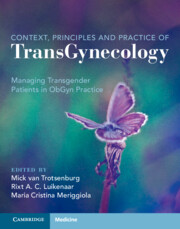Book contents
- Context, Principles, and Practice of Transgynecology
- Context, Principles, and Practice of Transgynecology
- Copyright page
- Dedication
- Contents
- Foreword
- Preface
- Contributors
- Abbreviations
- Section A Contextual Transgynecology
- Section B Practicing Transgynecology
- Section C Gynecological Surgery for Transgender Males
- Section D Sexuality and Contraception
- Chapter 21 Transition-related Sexual Health Care
- Chapter 22 Contraceptive Advice for Trans Male Persons
- Chapter 23 Sexual Abuse and Trauma-informed Care for Transgender and Gender Diverse People in Ob/Gyn Practice
- Section E Fertility and Reproduction
- Section F Impact of Gender-affirming Hormonal Therapy on Genital Organs
- Section G Screening and Prophylaxis
- Transgynecology Index
- References
Chapter 22 - Contraceptive Advice for Trans Male Persons
from Section D - Sexuality and Contraception
Published online by Cambridge University Press: 22 December 2022
- Context, Principles, and Practice of Transgynecology
- Context, Principles, and Practice of Transgynecology
- Copyright page
- Dedication
- Contents
- Foreword
- Preface
- Contributors
- Abbreviations
- Section A Contextual Transgynecology
- Section B Practicing Transgynecology
- Section C Gynecological Surgery for Transgender Males
- Section D Sexuality and Contraception
- Chapter 21 Transition-related Sexual Health Care
- Chapter 22 Contraceptive Advice for Trans Male Persons
- Chapter 23 Sexual Abuse and Trauma-informed Care for Transgender and Gender Diverse People in Ob/Gyn Practice
- Section E Fertility and Reproduction
- Section F Impact of Gender-affirming Hormonal Therapy on Genital Organs
- Section G Screening and Prophylaxis
- Transgynecology Index
- References
Summary
Unintended pregnancies among transgender men undergoing gender-affirming hormonal treatments (GAHTs) with testosterone (T) have been reported, and T cannot be considered a contraceptive method, due to the incomplete suppression of gonadal function. Despite that, awareness about the necessity of concomitant contraception during T treatment is lacking among transgender individuals, but also among clinicians. Data are scarce regarding the best contraceptive choice in transgender men: some considerations are the same as those for cisgender women, but benefits and risks of any contraceptive option should be discussed, recognizing differences in needs and concerns in this population. Trans men who still have their ovaries and uterus and engage in sexual activity with a person with a penis and testicles should be counseled regarding contraception. Gender-affirming hormone therapy (GAHT) alone should not be considered a reliable form of contraception. For this reason, this topic and the discussion of fertility and family planning should be covered before the start of GAHT and rediscussed during follow-up visits.
- Type
- Chapter
- Information
- Context, Principles and Practice of TransGynecologyManaging Transgender Patients in ObGyn Practice, pp. 168 - 171Publisher: Cambridge University PressPrint publication year: 2022

